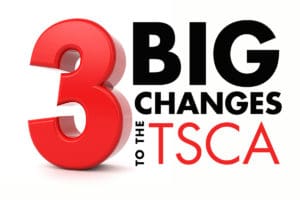After 40 plus years, the Toxic Substances Control Act (TSCA) was reformed for the first time! In June of 2016, President Obama signed into law an amended TSCA and gave the Environmental Protection Agency (EPA) a new scope with which to regulate manufacturing and production. There are three prominent changes that m ay impact your company, and knowing them can help you avoid significant fines.
ay impact your company, and knowing them can help you avoid significant fines.
Unreasonable Risk
EPA has a heightened focus on “unreasonable risk”—a term which refers to the burden of a manufacturer to demonstrate that a chemical substance poses no “unreasonable risk” to health or environment. Under the original TSCA, safety and hazard evaluations could be circumvented by manufacturers if the cost-to-benefit ratio did not justify the analysis. Now however, under the amended TSCA, EPA has the ability to require safety/hazard assessments, without regard to the cost-to-benefit ratio.
Worker Exposure
The new TSCA also takes into account the exposures of workers in certain industries. The law employs the phrase “susceptible subpopulation” to identify workers who may be more frequently exposed to a particular chemical substance than the general population. This segments’ exposure now must also be taken into account during the safety/hazard assessment required for EPA approval.
Chemical Hazards
Another significant change to TSCA is that Section 6 of the law now prioritizes chemicals based on risk, where “risk” is determined on the basis of a chemical substance’s hazards as well as its potential for exposure, either to humans or the environment. In light of this new prioritization approach, EPA has announced that it will be conducting its first safety assessment, starting with the following:
- 1,4-dioxane (solvent present in inks and adhesives)
- 1-bromopropane (used to “dry-clean” your clothing)
- Asbestos (used in the production of table salt)
- Carbon Tetrachloride (previously used in dry-cleaning of clothing, refrigerants, etc.)
- Cyclic Aliphatic Bromide Cluster (flame retardant on clothing and electronics)
- Methylene Chloride (used to decaffeinate coffee and strip paint)
- N-methylpyrrolidone (production of lithium ion batteries)
- Pigment Violet 29 (textile dye—think of the purple shirt hanging in your closet)
- Tetrachloroethylene (dry-cleaning, degreasing, etc.)
- Trichloroethylene (dry-cleaning, degreasing, etc.)
EPA has three years to complete their risk evaluation of the above ten substances. If results of the evaluation show that a substance poses an “unreasonable risk” to humans or the environment, EPA must then propose a plan to reduce or mitigate that risk within two years of the findings.
Need more information or guidance on how the amended TSCA impacts your company?
Global Safety Management (GSM) is closely monitoring the Toxic Substances Control Act changes and our GSM specialists are prepared to discuss these updated regulations and what their impact means for your company. We offer a range of affordable Regulatory Consultation Packages to provide the best investment for clients who need reliable, timely updates and/or assistance with meeting regulatory registration. While it is the customer’s discretion on how to use the Regulatory Consultation information, the materials received, including the citations, save countless man hours of research and interpretation. Contact us at GSM to inquire about the packages available for your company.


